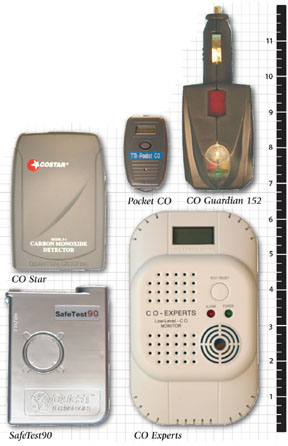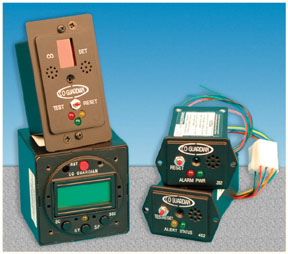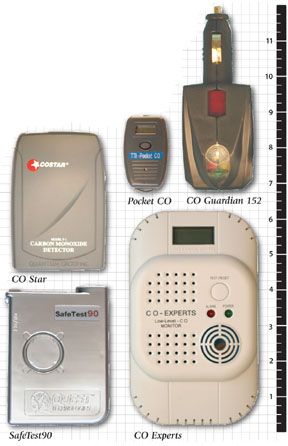
by Ben Barnard
Less than a decade ago, nobody paid much attention to carbon monoxide poisoning in the cockpit. Indeed, only one company made a so-called biomimetic patch detector that turned black in the presence of carbon monoxide and few owners even bothered with them. But the advent of cheap, sophisticated electronic detectors and a couple of high-profile accidents in which leaky heater muffs were implicated changed all that.
Now, you can buy a range of CO detectors suitable for the cockpit, ranging from relatively inexpensive portable devices to at least one panel-mount device that combines CO detection with a clock, voltage monitoring and other functions. Since we last reviewed detectors, some products have been pulled from the market, such as the Senco Model One. But a handful of new products have appeared so there are more options to pick from than ever.
But do you really need one? Thats a question were not sure we can answer. The number of accidents and incidents known to be directly caused by carbon monoxide is so small as to be masked by statistical noise. Some fatal accidents have no apparent cause and could be attributed to CO poisoning, but the evidence is not conclusive. If CO looms large as one of your demons, detectors are a cheap way to address that fear. Otherwise, plenty of other gadgets compete for your limited dollars. we’ll stop short of saying these devices are must-have equipment.
What We Tested
The CO detection market is a niche within a niche but there’s plenty of variety and price choice, ranging from $5 to $800. For evaluation purposes, the detectors break into two major categories: portable or panel mount.Speaking of portables, why not just buy a battery-operated hardware store model and toss it on the backseat? The answer is that home-type detectors lack low-level detection capability and if youre worried about CO-induced impairment, detecting concentrations below 50 parts per million is a must. We think any detector worthy of purchase should have good sensitivity, quick response time, alarms you can readily see or hear and be unobtrusive and easy to maintain.
To gain a sense for how we’ll these devices work, we placed each one in a sealed 15-gallon glass fish tank and exposed them to reagent-grade carbon monoxide we purchased from a commercial gas supplier. For low-level testing, the regulator on our CO bottle leaked just enough around its valve seat to slowly fill the tank to 50 PPM and higher. For benchmarking, we used a SafeTest 90, an industrial-grade electrochemical sensor capable of measuring concentrations as low as 1 PPM. At $295, this is an expensive portable detector but if cost isn’t a factor, we also think its the best.
CO Patches
Before carbon monoxide became the hazard du jour, the only practical way to detect its presence was with a patch-type detector, the most popular of which was marketed under the name Dead Stop, among others. As explained in the sidebar, these are biomimetic devices whose chemical compounds turn black in the presence of CO. We tried two of these, the classic Dead Stop patch and the newer Quantum Eye made by Quantum Group, Inc. Aircraft Spruce and Specialty sells the Dead Stop for $3.50; its $4.95 from Sportys Pilot Shop. The Quantum Eye retails for $5.90 from Aircraft Spruce and $11.95 from Sportys. These detectors have been the butt of many a joke, which has lead many to the conclusion that they don’t work. But our tests reveal that this isn’t true; the patch detectors do function as claimed. What they don’t do is detect low levels of CO, so there’s little chance that a patch detector will quickly alert you to, say, the 100 PPM of CO that could cause impairment.
The Dead Stop has been on the market for at least a decade. It has a biomimetic spot affixed to a two-inch square plastic panel with an adhesive backing. The orange spot darkens when exposed to CO. The Dead Stop performed reasonably we’ll in our test, twice turning pitch black after two minutes of exposure at around 400 PPM.
However, this was after an initial trial where the spot didnt darken until exposure at over 500 PPM for 15 minutes. The test revealed the weaknesses of inexpensive patch sensors: Theyre imprecise and don’t provide reliable low-level detection.
The instructions on the back of the Dead Stop advise that it be replaced every 90 days or more frequently if the sensor is exposed to a litany of chemicals and atmospheric conditions as explained in the sidebar. An orange ring around the sensor serves as a color reference. If the sensor gradually turns darker or bleaches out, it should be replaced.
Quantum Eye
This is the next step up in passive patch sensors. Like the Dead Stop, the Quantum Eye has a biomimetic sensor, but this one is encased in plastic with small ventilation holes in front of the sensor. The plastic casing can be affixed inside the cockpit with an adhesive patch or a magnet. The Quantum Eye is touted as a multilevel sensor with three color codes; yellow for normal, green for caution and black for danger. In reality, the color transformation is nearly the same as the Dead Stop, turning from orange to black in the presence of CO. But the Quantum Eye has a key to interpret the change, while the Dead Stop doesnt.
The Quantum Eye outperformed the Dead Stop in our test. Like the Dead Spot, it responded slowly during the first trial, turning pitch black after 7:30 with a CO concentration around 200 PPM. Subsequent tests saw faster response times, averaging less than two minutes.
The instructions for the Quantum Eye suggest that it be replaced every 18 months, although its subject to the same set of life-limiting threats as the Dead Stop. Given its longer advertised lifespan and its increased sensitivity, we think that the Quantum Eye is worth the extra few dollars if youre looking for a passive patch detector. But, again, it lacks low-level sensitivity.
Battery-Powered Portables
Battery-powered portable CO detectors have long been used in the mining and petroleum industries to detect dangerous gases in confined areas. Industrial-grade sensors cost hundreds and even thousands of dollars and arent necessary for GA applications. Some companies that make these sensors are prohibited by their insurers from marketing to pilots because of worries about exposure to lawsuits. (No surprise there.)
However, some battery-powered portables of the industrial lineage are marketed in the aviation segment. We tested four of these devices: CO Star P1 from Quantum ($43); CO Experts Model 2004 ($124); Pocket CO from Transducer Technologies Incorporated ($129) and the Safe Test 90 from Quest Technologies ($295).
CO Star P1
The CO Star P1, also from Quantum, is the least expensive battery-powered portable we tested. It has a time-weighted, biomimetic sensor that calculates the rate at which the concentration of CO is rising. Time-weighted sensors are used to prevent the kind of nuisance alarms that lead users to distrust and even detest their detectors. The sensor triggers an audible alarm and a blinking red light. The 85 dB alarm-loudness typical of these portables-is ear-piercing and easily heard through a noise-reducing headset.
With its time-weighted sensor, the P1 is not designed for low-level detection. According to the manufacturers specs, it will alarm at 70 PPM after 240 minutes, 50 minutes at 150 PPM and 15 minutes at 400 PPM. In our view, this response time is not practical for cockpit use, although its superior to the biomimetic patch.
In our tests, the P1 consistently alarmed after five to seven minutes at concentrations around 1000 PPM. But at this level of CO intrusion, you should be able to self-diagnose impending CO poisoning before getting confirmation from the P1. Quantum recommends that you replace the P1 after five years after the date of purchase.
SafeTest 90
The SafeTest 90 is an industrial-grade detector that moonlights as CO detector for GA. Its a high-quality precision instrument thats all the serious CO protection you could ever want. But at $295, its probably more than you need.
It has an electrochemical sensor, a backlit digital display, annunciator lights and a loud, annoying siren, all housed in a stainless steel case about the size of a pack of cigarettes and powe red by a 9-volt battery. It provides readings in real time and in a time-weighted average, beginning at 1 PPM. We used the SafeTest 90 as our benchmark detector because of its sensitivity and accuracy. If youre looking for the best portable battery-powered CO detector out there and youre not afraid of the price tag, the SafeTest 90 is the one to pick.
CO Experts Model 2004
CO Experts Model 2004 is designed for low-level detection, although it does this in a package we would hardly call compact. The 2004 measures 3.75 x 1.75 x 6 inches high, so you’ll have to find a place for it on the cockpit floor or a seat. It has an electrochemical sensor and will measure and display concentrations down to 10 PPM, with a visual alert-a digital readout-at that level. From 25 to 50 PPM, it gives both a visual and audible alert, with decreasing intervals between the 85 dB beeps. It gives a full, sustained alarm at 70 PPM. The Model 2004 has a test button that doubles as a hush feature, a good thing to have on a detector this sensitive. Its otherwise prone to nuisance alarms.

During our test, the Model 2004 consistently alarmed according to its manufacturers specs, which are in line with how we expect a cockpit CO detector to function. Re-calibration and warranty renewal is available for $40 per unit, per year. While thats a bit of hassle, if youre really convinced you need low-level detection, calibration is a must.
CO Guardian
This Tucson, Arizona-based company offers an array of portable and panel-mount CO detectors that operate on ships power. We tested several panel-mount models (252-F, 352, 452, 552) and the 152, a portable that plugs into an auxiliary power outlet. CO Guardian uses electronic solid-state sensors in their detectors that need to be warmed up for a few minutes before they work properly; all but the 152 feature internal fans that circulate air through the sensor. Most of them are designed to sense CO at concentrations between 40 and 999 PPM and alarm at 50 PPM. This baseline is set according to an ancient FAA regulation that limits the acceptable level of CO in the cockpit to 50 PPM. That reg dates to the days before CO was deemed to be the cockpit hazard that it is now.
All of the CO Guardians also have 85 dB audible alarms. The 152 ($199) and 252-F ($369) have clear, bright-red digital displays while the 352 ($369) and 452 ($495)-TSO certified and tested to 25,000 ft.-have a red warning light to augment their alarms. Our testing confirmed that these detectors operate according to their manufacturers specifications, which preclude them from offering the kind of low-level detection you can get from the CO Experts, SafeTest 90 or the Pocket CO for less money. Bottom line: The cockpit could be hovering around 30 PPM of CO intrusion and these detectors wouldnt notice.
The 552 ($895) is a multifunction detector that will sense CO (starting at 30 PPM), in addition to serving as a second clock, timer, digital altimeter and voltage meter. Our first evaluation sample failed to detect CO. A second one sent to us by CO Guardian did work correctly, although we found its real time readings of the CO level present in our test chamber to be slower than the SafeTest 90.
CO Guardian says that all of their units have a lifespan of five to seven years if not exposed to any of the myriad things that can kill them, mainly fumes from hydrocarbon solvents. They also recommend that their units be overhauled after three years, which costs $99 for any of the products and includes the installation and recalibration of a new sensor.
Pocket CO
The Pocket CO from TTI is the newest detector being pitched in the GA market. Its remarkable for its small size-it fits easily in a shirt pocket or on a key chain-and its capabilities. It has a digital display that will read the level of CO between 1 and 600 PPM and will alarm at concentrations above 25 PPM. It has an electrochemical sensor with a self-test function and provides readings in real time and in a time-weighted average.
Our tests revealed the Pocket CO to be sensitive and resilient enough to consistently provide accurate readings after multiple heavy exposures. There are, however, some problems with this detector. First, the alarm is not nearly loud enough. While the other detectors in our test sported piercing 85 dB alarms, the Pocket COs alarm is a piddling little chirp that were sure would go unnoticed in the typical loud cockpit. If you suspected CO intrusion, the Pocket CO could confirm it, but unless you mount it somewhere in your scan, it wont otherwise get your attention.
The second problem is that the Pocket CO has a life span of about a year of heavy use or two to three years of moderate use. TTI will discount your purchase of a new Pocket CO after one year. But still, at $129 retail (from Aeromedix.com), this isn’t a cheap prospect.
Recommendations
Its tempting to overstate the threat posed by CO in the cockpit and easier still to spend more money than you need to in order to protect yourself from it. Yes, CO is a potential problem but not a huge one, in our view. Each owner will have to decide for himself how big a worry CO is and what to do about it.
If CO is low on your list of fears, the Quantum Eye will at least detect high levels of CO if you notice physiological symptoms. But we don’t think its suitable for warning of low-level CO ahead of symptoms becoming obvious. If proactive low-level detection appeals to you and cost isn’t a factor, the SafeTest 90 is the best thing going. Its accurate, reliable and has an alarm to wake the dead. At $295, its not overpriced but that still may be more than you want to spend. In that case, best-value choices are CO Experts Model 2004 and Pocket CO from TTI. Both give you accurate, low-level CO readings for less than the SafeTest 90 or the CO Guardians. Neither of these choices is ideal, either, in our view. The CO Experts is big and bulky and the Pocket COs alarm is wimpy, in our estimation. But its small enough to live on your key chain as a means of confirming CO if symptoms appear.
We like the CO Guardians and they appear accurate and reliable. But they lack low-level sensing and the effort of mounting a sensor in a crowded panel isn’t our first choice. The portable 152 plugs into a cigarette accessory socket, if youre willing to surrender that power source to CO detection.But, again, the 152 lacks low-level detection.
Also With This Article
“Checklist”
“Product Description And Price”
“CO Sensing Science”
Contacts
Aeromedix.com (CO Experts, Pocket CO), 888-362-7123, www.aeromedix.com
CO Guardian, 800-639-7139, www.COGuardian.com
Sportys Pilot Shop, 800-776-7897, www.sportys.com
Aircraft Spruce and Specialty, 877-477-7823, www.aircraftspruce.com
-Ben Barnard is Aviation Consumers assistant editor.





